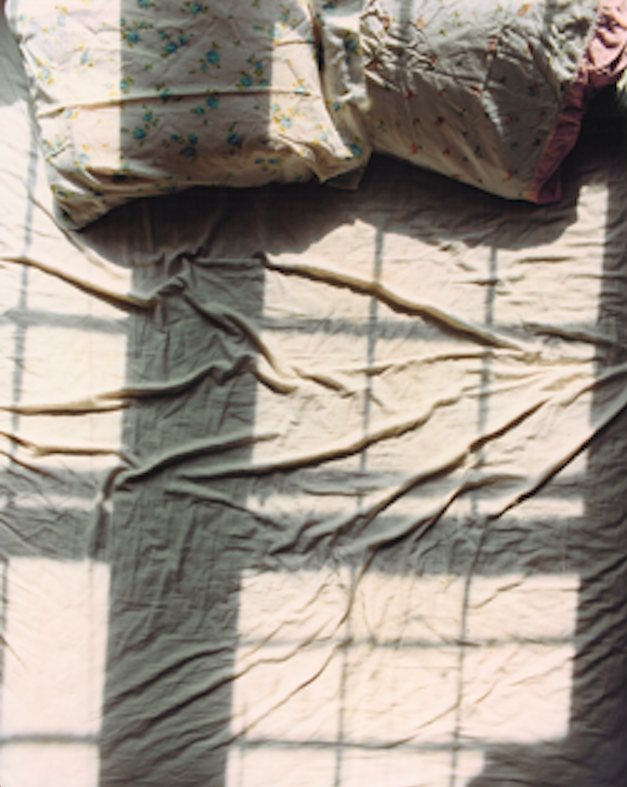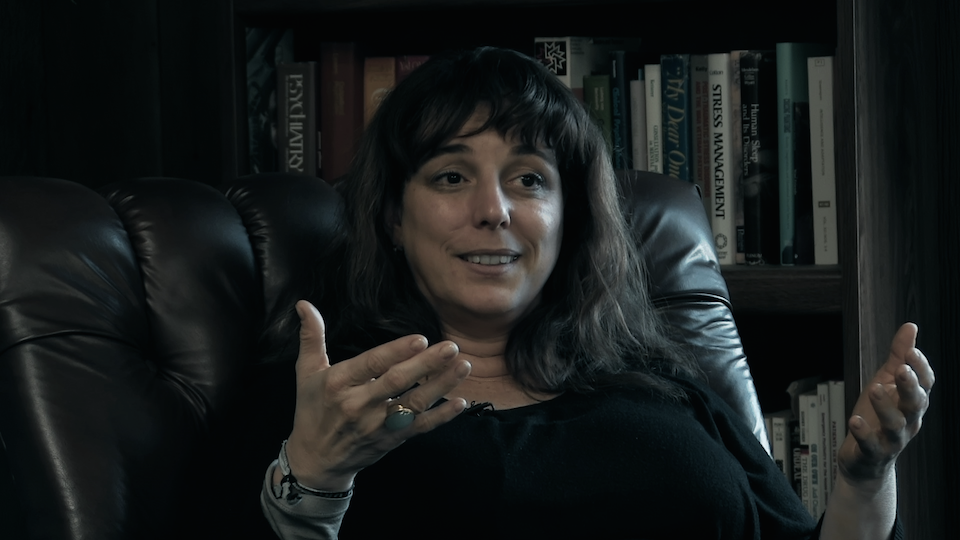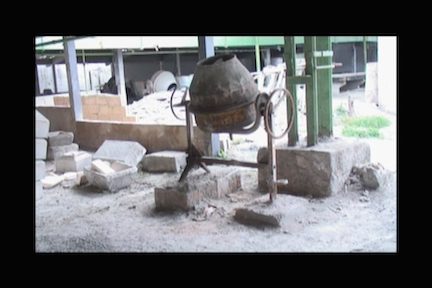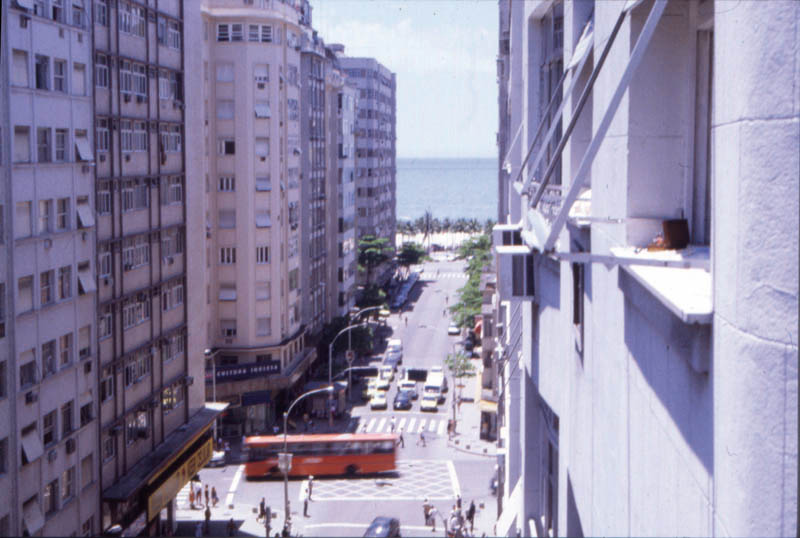
© » KADIST
Christian Salablanca
Hueso de culebra (Snake Bone) arises from the stories that the artist’s grandmother used to tell him as a child about her father’s medical and spiritual practices in the southern part of Costa Rica, close to the border with Panama. One of them revolved around a plant that had various uses, from healing poisonous snake bites to predicting the future. She said, for example, that if one came across this plant during a period of drought, it could mean trouble was coming.

© » KADIST
Andrés Pereira Paz
Juan III (Pescadores En Una Isla) is a series of embroideries made with fake pre-Columbian fabrics produced by the Gonzales family, a three-generation family of pre-Columbian textile “forgers” based in Lima, Peru. The members of this family (grandfather, father, and son) all bear the name of Juan and make replicas by hand using traditional methods nearly indistinguishable from the pieces made thousands of years ago. A forgery pretends to be something it is not, but the Gonzalez family’s textiles openly intend to recreate those discovered in the 1920s at a necropolis in Peru.

© » KADIST
davi de jesus do nascimento
Drawing & Print (Drawing & Print)
davi de jesus do nascimento’s earthy paintings, from the series sorvedouro , recall his memories as an essentially organic matter. Watercolor painting carries water as its foundational element and was the first technique that the artist applied to base his painting research on the river. He used to dip the brush on the prow of the boats: “I realized that the water is in deep dialogue with the flows of the river that I descend”.

© » KADIST
Laís Amaral
Drawing & Print (Drawing & Print)
Laís Amaral abstract paintings dialogue with the feminine power. Just like the flow of a river, Laís produces her paintings as a flux that emerges from within, an inner force that relates to all the women in her life, family, and ones who know the medicinal powers of nature; who are part of this feminine force latent in the earth. In order to discover elements about herself, Laís Amaral understands painting as a gesture of leakage.

© » KADIST
Adrian Melis Sosa
Shot a few months before the USA and Cuba restored diplomatic relations in 2015, The New Man and My Father looks into the quiet aftermath of one family’s individual experience of the Cuban Revolution (1953-1959). The film brings to the fore a socio-political system made for a country whose successes and failures fell upon the individual men and women who experienced it. In the film, Melis interviews his father about the Cuban Revolution, as well as the more recent re-introduction of capitalism to the island after 60 years of the US-imposed embargo.

© » KADIST
Manuel Correa
Manuel Correa’s documentary Four Hundred Unquiet Graves is a powerful and vulnerable visual essay about the descendants of those who were disappeared during the Spanish Civil War from 1936–1939. The film reveals the spectrum of violence that surrounds the war, namely the impact of thousands of forced disappearances on different generations. Surviving family members are haunted not only by the absence of their grandparents, but also by the overwhelming grief that lives in their parents.

© » KADIST
Sadie Barnette
Winfield St by Sadie Barnette depicts a seldom documented scene of men and boys in an intimate domestic setting. In the large format photograph three young boys and a man sit at a dining room table, eating a meal together. One boy is mid-bite, while another looks directly at the camera, obscuring the face of the adult.

© » KADIST
Diamond Stingily
Dad is Byron is an audio work produced in collaboration between Diamond Stingily and her father, the house musician Byron Stingily. Viewers are invited to pick up a wall-mounted telephone that has been retrofitted to play a recording of a conversation between Stingily and her father. Although initially the artist planned to focus on her father’s recollections of the violence during his childhood in Chicago in the 1960s and how music helped him cope, the conversation has a natural and intimate meandering.

© » KADIST
Ilana Bar
One of Ilana Bar’s best-known works is the series Transparências de lar (Home Transparencies) in which, for four years, the artist photographed her family’s rural home in Atibaia where her father lives with his two brothers and Ilana’s own brother, all three with Down Syndrome. Transparências de lar is the record of a serene, though certainly not a perfect, place. In this place Down Syndrome is not considered an alienable difference in the way that it is in Western culture, it is not problematic or a cause for social exclusion.

© » KADIST
Joanna Piotrowska
This selection of photographs taken between 2014 and 2019 focus on Piotrowska’s long-term preoccupation with issues of domesticity and containment. The images depict young isolated women in domestic environments, holding various unnatural postures: we see a hand raised to a face, as if in a trance; limbs precariously balanced or ambiguously entangled, contorted against an unseen adversary. It is unclear whether gestures are benign or threatening, whether these women are menacing or being menaced.

© » KADIST
Nidhal Chamekh
Drawing & Print (Drawing & Print)
Nidhal Chamekh made the first drawings of the ongoing series Mémoire Promise in 2013. In the series, the artist persistently dissects, examines and describes his experiences and memories of his family and life in Tunis, Tunisia. As underlined by poet Arafat Sadallah, the artist draws eyes and gazes of unachieved portraits, hands and arms of a skeleton—figures disappear but they witness and testify.

© » KADIST
Nidhal Chamekh
Drawing & Print (Drawing & Print)
Nidhal Chamekh made the first drawings of the ongoing series Mémoire Promise in 2013. In the series, the artist persistently dissects, examines and describes his experiences and memories of his family and life in Tunis, Tunisia. As underlined by poet Arafat Sadallah, the artist draws eyes and gazes of unachieved portraits, hands and arms of a skeleton—figures disappear but they witness and testify.

© » KADIST
Phan Quang
Phan Quang’s portrait series Re/cover grapples with a lesser-known history in Vietnam. After World War II, many Japanese soldiers who fought in Vietnam stayed in the country. They married Vietnamese women, had children, and lived in the country until Japan recalled them home.

© » KADIST
Natalia Lassalle-Morillo
In her film Retiro (2019), Natalia Lassalle-Morillo considers how women pass down memories to their kin as they age. A film within a film, the three-channel portrait combines the scripted film she and her mother made together, behind-the-scenes shots of that film’s production, and interviews with her mother on gendered familial expectations and aging in Puerto Rico. Lassalle-Morillo’s meta approach to story-telling unpacks her relationship to her mother, demonstrating how maternal trauma, history, and myth are made and inherited through disjointed narratives.

© » KADIST
Akiq AW
In the Family Portrait series, Akiq AW documents reliefs and statues in Jogja, Indonesia that present an image of the ideological nuclear family. Following Indonesia’s communal and political conflicts, and its economic collapse and social breakdown of the late 1950s to the mid-1960s, the second Indonesian President Suharto established the “New Order” regime. During this period, there were efforts to control the national birth rate through a programme called Keluarga Berencana (Family Planning).

© » KADIST
Joanna Piotrowska
This selection of photographs taken between 2014 and 2019 focus on Piotrowska’s long-term preoccupation with issues of domesticity and containment. The images depict young isolated women in domestic environments, holding various unnatural postures: we see a hand raised to a face, as if in a trance; limbs precariously balanced or ambiguously entangled, contorted against an unseen adversary. It is unclear whether gestures are benign or threatening, whether these women are menacing or being menaced.

© » KADIST
Wang Mowen
In Trinity , Wang Mowen uses video to tell the story of a young woman who wants to know the whereabouts of a person born sixty years ago. She visits three fortune tellers and provides the person’s birth date. Each psychic deliberates and comes to the correct conclusion that the woman in question is the seeker’s mother.

© » KADIST
Dannielle Bowman
Vision (Bump’n’Curl) by Dannielle Bowman is from a series of photographs titled What Had Happened . The series blends a major historical event with small, personal images. The photographs retain fragments of the artist’s own heritage and investigate the concept of home, while gaining inspiration from the Great Migration, a movement in which African Americans from the South (including Bowman’s grandparents) moved to the North, and also the American West from 1916-1970.

© » KADIST
Joanna Piotrowska
This selection of untitled photographs taken between 2014 and 2019 focus on Joanna Piotrowska’s long-term preoccupation with issues of domesticity and containment. The images depict young isolated women in domestic environments, holding various unnatural postures: we see a hand raised to a face, as if in a trance; limbs precariously balanced or ambiguously entangled, contorted against an unseen adversary. It is unclear whether gestures are benign or threatening, whether these women are menacing or being menaced.

© » KADIST
Vuth Lyno
25 by Vuth Lyno addresses the legacy of the UN’s 1992-93 peacekeeping operation in Cambodia (UNTAC). This operation steered the country’s transition out of three decades of war and destruction—civil war, the Khmer Rouge era (1975-79), and the factional conflicts of the 1980s—towards a new, ‘democratic’ future. It was the most ambitious and successful UN peacekeeping mission of its time.

© » KADIST
Malik Nejmi
La Chambre Marocaine series is a means to reconnect personally to his connection to family history and objectively assess the process of reconnection. By creating this work in the Villa Medici in Rome, the neutral space—neither France nor Morocco—allowed the artist to distance himself with his history in the examination process. The series looks at Morocco through the eyes of his children and object belonging to his grandmother: a scarf, a cushion and a book in Arabic.

© » KADIST
Rebecca Quaytman
R. H. Quaytman’s family on her father’s side is of Jewish heritage from Poland. In the summer of 2016, Quaytman traveled to Poland to research an upcoming retrospective exhibition taking place in Warsaw and ?ódz, the town from which her great-grandfather emigrated to the United States. Tracing her grandfather’s and great-grandfather’s origins, Phocis Pole is from a series of paintings that explores her paternal lineage.

© » KADIST
Joanna Piotrowska
This selection of photographs taken between 2014 and 2019 focus on Piotrowska’s long-term preoccupation with issues of domesticity and containment. The images depict young isolated women in domestic environments, holding various unnatural postures: we see a hand raised to a face, as if in a trance; limbs precariously balanced or ambiguously entangled, contorted against an unseen adversary. It is unclear whether gestures are benign or threatening, whether these women are menacing or being menaced.

© » KADIST
Chto Delat
In this film is the story of two neighboring yet philosophically opposing nations: Russia and Norway. Taken through a love-story of the main character Tanja and her newfound Norwegian husband, the film challenges cultural and social norms of both places through the format of a musical. Dealing with issues of individual in society, family and moral values, Chto Delat entices the audience to consider the nuances of these two contexts.

© » KADIST
Akram Zaatari
“While taking the picture it was challenging to make the boys sit properly without moving. Sometimes a member of the family whould hide behind, holding the child.” Hashem El Madani. Hashem El Madani, a studio photographer in Saida, began working in 1948.

© » KADIST
D’Angelo Lovell Williams
On January 7th, 2020, artist D’Angelo Lovell Williams was diagnosed with HIV. Only a handful of chosen family members knew up until the public announcement that coincided with the release of this body of work. According to the artist, “discovery” is key to this group of large photographs.

© » KADIST
Sadie Benning
In borrowing and subverting images from popular culture, Sadie Benning exposes the media’s role in constructing false and oppressive stereotypes of women, with regard to gender and sexual identity. This small painting, titled Mom , is a concise, eloquent visual statement. Many of her paintings incorporate found imagery, family photos, and everyday objects.

© » KADIST
Danh Vo
Good life (2007) is an installation displaying letters, documents, photographs and objects from a man named Joseph Carrier, and appropriated by artist Danh Vo. The installation features a series of small square vitrines, inset, dark and precisely spot-lit. Inside these are framed photographs, mostly black and white, of young Asian men, taken, as the titles on the neat brass name plates tell us, in Vietnam in the 1960s and early 1970s.

© » KADIST
Tammy Rae Carland
Carland’s series of large-format photographs Lesbian Beds (2002) depicts beds that have been recently vacated. Shot from directly above, they are lavish views of very private spaces. The artist plays to her viewers’ voyeuristic impulses, inviting us to look, but then denying us the opportunity to study the figures to whom the sheets belong, so that the rumpled covers become like anthropomorphic stand-ins inviting empathic projection.
Joanna Piotrowska
Photographer and filmmaker Joanna Piotrowska explores issues such as the female condition, family dynamics, and post-Soviet Poland, through black and white images that depict the quotidian...
Nidhal Chamekh
Based between his native Tunis and Paris, Nidhal Chamekh’s work is an investigation into history as a point of access to our contemporary times...
Lynn Hershman Leeson
- location: San Francisco, California
- year born: 1941
- gender: female
- nationality: American
- home town: Cleveland, Ohio
Rebecca Quaytman
In her work, Rebecca Quaytman displays great interest in the dissolution of the image...
Dannielle Bowman
Working in photography, Dannielle Bowman’s photographs are multilayered, pushing a more nuanced understanding of American history and culture across various physical locations and time periods...
Danh Vo
- location: Berlin, Germany
- year born: 1975
- gender: male
- nationality: Vietnamese and Danish
- home town: Ba Ria, Vietnam
Malik Nejmi
The practice of the French-Moroccan artist Malik Nejmi (b...
Wang Mowen
Trained as a photographer, artist Wang Mowen was born and raised in Dalian and she currently lives and works in Beijing...
Yeni Mao
Yeni Mao’s sculptures have a narrative undertone and are frequently autobiographical, with regard to the Canadian Chinese artist’s transnational background...
Phan Quang
Visual artist and photographer Phan Quang stages nuanced compositions that illustrate the relationship between global historical events and the personal histories of families and communities in Vietnam...
Adrian Melis Sosa
Adrian Melis’s work is committed to presenting the range of intensity and nuance of human energy embodied through acts of resistance, resilience, and productivity...
Akram Zaatari
- location: Sayda, Al-Lubnan
- year born: 1966
- gender: male
- nationality: Lebanese
Akiq AW
Akiq AW is primarily a photographer whose ongoing projects investigate everyday life and how humans face reality through innovation and strategies of their own creation...
Natalia Lassalle-Morillo
Natalia Lassalle-Morillo’s films explore familial, neighborly, and citizen relationships in the context of Puerto Rico’s fraught history with the United States and the resulting imperialist oppression that has altered generations of families’ material and spiritual trajectories...
Tammy Rae Carland
Using photography, text, and video, Tammy Rae Carland tactically realigns traditional ideas of love, partnership, domesticity, and family...
Ilana Bar
Ilana Bar is a Brazilian artist, photographer and researcher...
davi de jesus do nascimento
davi de jesus do nascimento grew up in Pirapora, a town in the north of Minas Gerais, which guides the narratives of his work, as does the heritage of his family of fishermen, laundresses, and Carranca masters...
Manuel Correa
Manuel Correa’s practice deals with the reconstruction of post-conflict intergenerational memory in contemporary societies...
Vuth Lyno
Vuth Lyno’s artistic practice operates at a crucial intersection of contemporary Khmer culture...
Diamond Stingily
Diamond Stingily works in a wide variety of media, from spoken word, video and audio to sculpture and installation...
Christian Salablanca
Costa Rican artist Christian Salablanca Díaz has developed a body of work around the phenomenon and experience of violence and the ways in which it generates, determines, and conditions history, society, and politics...
Sadie Barnette
Sadie Barnette’s practice calls attention to family and community histories through photography, drawing, sculpture, and installation...
Chto Delat
Chto Delat was founded in 2003 and consists of a group of artists, critics, philosophers, and writers from Petersburg, Moscow, and Nizhny Novgorod...
Sadie Benning
When she was fifteen Sadie Benning’s father gave her a kiddie PixelVision camera, a device that recorded grainy black-and-white video on standard audio cassettes...
-
1950-1959
Akram Zaatari
1950“While taking the picture it was challenging to make the boys sit properly without moving...
-
2000-2009
Tammy Rae Carland
2002Carland’s series of large-format photographs Lesbian Beds (2002) depicts beds that have been recently vacated...
Lynn Hershman Leeson
2007Lynn Hershman Leeson’s genre-bending documentary Strange Culture tells the story of how one man’s personal tragedy turns into persecution by a paranoid, conservative, and overzealous government...
-
2010-2019
Motoyuki Daifu
2010Seven family members and a cat all squeezed into the small five-room house, where Motoyuki Daifu grew up in Yokohama...
Phan Quang
2013Phan Quang’s portrait series Re/cover grapples with a lesser-known history in Vietnam...
Malik Nejmi
2014La Chambre Marocaine series is a means to reconnect personally to his connection to family history and objectively assess the process of reconnection...
Adrian Melis Sosa
2015Shot a few months before the USA and Cuba restored diplomatic relations in 2015, The New Man and My Father looks into the quiet aftermath of one family’s individual experience of the Cuban Revolution (1953-1959)...
Joanna Piotrowska
2015This selection of photographs taken between 2014 and 2019 focus on Piotrowska’s long-term preoccupation with issues of domesticity and containment...
Joanna Piotrowska
2015This selection of untitled photographs taken between 2014 and 2019 focus on Joanna Piotrowska’s long-term preoccupation with issues of domesticity and containment...
Joanna Piotrowska
2015This selection of photographs taken between 2014 and 2019 focus on Piotrowska’s long-term preoccupation with issues of domesticity and containment...
Nidhal Chamekh
Drawing & Print
2016(Drawing & Print) Nidhal Chamekh made the first drawings of the ongoing series Mémoire Promise in 2013...
Nidhal Chamekh
Drawing & Print
2016(Drawing & Print) Nidhal Chamekh made the first drawings of the ongoing series Mémoire Promise in 2013...
Diamond Stingily
2017Dad is Byron is an audio work produced in collaboration between Diamond Stingily and her father, the house musician Byron Stingily...
Sadie Benning
2017In borrowing and subverting images from popular culture, Sadie Benning exposes the media’s role in constructing false and oppressive stereotypes of women, with regard to gender and sexual identity...
Andrés Pereira Paz
2018Juan III (Pescadores En Una Isla) is a series of embroideries made with fake pre-Columbian fabrics produced by the Gonzales family, a three-generation family of pre-Columbian textile “forgers” based in Lima, Peru...
Sadie Barnette
2018Winfield St by Sadie Barnette depicts a seldom documented scene of men and boys in an intimate domestic setting...
D’Angelo Lovell Williams
2018On January 7th, 2020, artist D’Angelo Lovell Williams was diagnosed with HIV...
Joanna Piotrowska
2019This selection of photographs taken between 2014 and 2019 focus on Piotrowska’s long-term preoccupation with issues of domesticity and containment...
Natalia Lassalle-Morillo
2019In her film Retiro (2019), Natalia Lassalle-Morillo considers how women pass down memories to their kin as they age...
Wang Mowen
2019In Trinity , Wang Mowen uses video to tell the story of a young woman who wants to know the whereabouts of a person born sixty years ago...
Dannielle Bowman
2019Vision (Bump’n’Curl) by Dannielle Bowman is from a series of photographs titled What Had Happened ...
-
2020-2029
Manuel Correa
2020Manuel Correa’s documentary Four Hundred Unquiet Graves is a powerful and vulnerable visual essay about the descendants of those who were disappeared during the Spanish Civil War from 1936–1939...
Christian Salablanca
2021Hueso de culebra (Snake Bone) arises from the stories that the artist’s grandmother used to tell him as a child about her father’s medical and spiritual practices in the southern part of Costa Rica, close to the border with Panama...
davi de jesus do nascimento
Drawing & Print
2022(Drawing & Print) davi de jesus do nascimento’s earthy paintings, from the series sorvedouro , recall his memories as an essentially organic matter...
Laís Amaral
Drawing & Print
2022(Drawing & Print) Laís Amaral abstract paintings dialogue with the feminine power...











